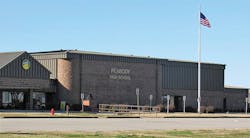SCHOOL DISTRICT LEADERS are dedicated to providing students, faculty and staff with a comfortable environment that encourages learning and productivity. Limited budgets, however, can often deter this objective if school infrastructure is aging, resulting in inefficiencies. A common and costly inefficiency is water waste. Leaks in plumbing systems can cost school districts thousands of dollars a year and cause potentially long-term damage to building infrastructure. By investing in water conservation solutions, school districts can create a learning environment that is on the cutting edge of both education and environmental efficiency.
SMART SOLUTIONS FOR LONG-TERM SAVINGS
Maintaining several large buildings within a school district can be expensive, especially when equipment and systems require unanticipated maintenance. To help reduce costs associated with maintaining district infrastructure, investing in water conservation solutions can help.
Water conservation solutions can range from general plumbing improvements, like high-efficiency toilets, to smart technology implementations, like smart meters. Smart meters collect data from integrated management systems to detect costly leaks and track inefficiencies. These insights allow for tailored operations based on real-time information, preventing long-term effects of undetected and unaddressed issues.
When integrated with other energy-efficient solutions, water conservation strategies can even help during emergencies. For instance, LED lighting can be integrated with smart meters to be used as a guide during a flood. Often used as open shelters in areas where flash floods are a threat, schools can be a central hub during evacuations. When smart meters and lighting are integrated, the meter’s sensors can automatically activate LED lighting to not only provide visibility but guide occupants to a safe location during an evacuation.
From improving efficiencies to reducing water usage or associated costs, these technology implementations can allow schools to reap significant benefits long term.
WATER CONSERVATION IN ACTION: TRENTON SPECIAL SCHOOL DISTRICT
One school district that implemented water conservation methods to contribute to the district’s overall efficiency was Trenton Special School District (Trenton SSD) in Trenton, Tenn. With an additional goal of providing a comfortable, productive learning environment for students, faculty, and staff, Trenton SSD underwent a retrofitting project spanning three different schools to address aging infrastructure, replace inefficient, outdated equipment, and maximize cost savings.
Water conservation installations throughout Trenton SSD included restrooms with improved flush volumes and new faucets, valves and fixtures to reduce water usage and the energy required to produce hot water. The school district saw a 17 percent savings as a direct result of this water conservation project, with more than $17,000 saved the first year. These savings will be reinvested into mechanical equipment upgrades to meet critical infrastructure needs throughout the school district, such as new rooftop units for temperature regulation to improve occupant comfort and updated fire alarm systems to enhance safety.
This water conservation project was part of a larger energy efficiency initiative estimated to produce more than $5 million in project benefits. Trenton SSD also implemented smart LED lighting and an energy management system to accurately track and analyze its energy usage. By taking a holistic approach to address water and energy efficiency, the school district was able to see widespread cost savings and improve internal operations throughout its schools.
With these investments, Trenton SSD freed up valuable capital to begin additional infrastructure upgrades to provide a sustainable and reliable school district while simultaneously improving the learning environment for students, faculty, and staff. Its schools now operate at peak efficiency, and they have the budget flexibility to continue to invest in their infrastructure and curriculum.
MAXIMIZE EFFICIENCY THROUGH SMART FUNDING
While water conservation can ultimately improve inefficiencies and reduce associated costs, for many school districts the up-front costs for these projects can seem daunting. However, achieving water and energy efficiency goals isn’t out of reach. Through the right funding programs, school districts can implement water conservation solutions within budget.
The Trenton SSD opted for Energy Performance Contracting (EPC). EPCs are backed by legislation at both the local and state level and guarantee that the savings garnered from infrastructure improvements will offset the cost of the project. To accomplish its project, Trenton SSD entered an EPC with an energy savings company (ESCO), a third party brought in to manage the project.
For Trenton SSD, the ESCO handled the design, construction, and installation of the retrofits. The ESCO helps mitigate risks, working closely with the customer to create a project road map that ensures the project remains outcome-driven and on schedule. These programs help to provide schools with the necessary resources to operate at their highest capacity, ultimately saving money down the road.
CONSIDER WATER CONSERVATION SOLUTIONS FOR LONG-TERM SAVINGS
Water inefficiencies throughout a school district can slowly mount to an expensive problem. By implementing conservation solutions, operational and energy efficiencies can be improved, all while reducing associated costs. Savings can then be redirected to additional infrastructure upgrades or extra-curricular activities. There is a water conservation solution to fit every district’s goals and budget and can transform operations and put dollars back into the school district.
About the Author
Fadi Kiameh
Fadi Kiameh is a Performance Infrastructure ™ business development manager for Johnson Controls.
